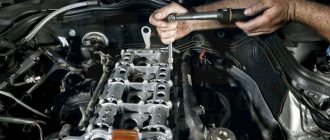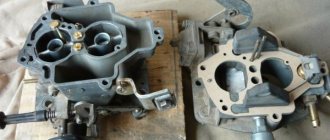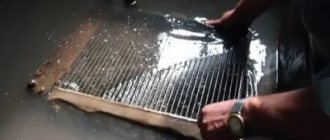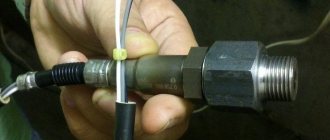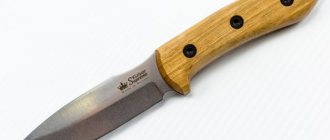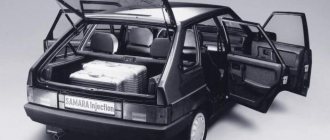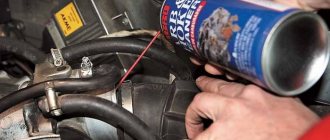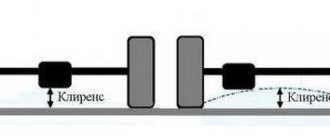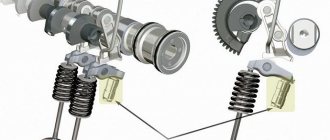Where to start if you want to service your car yourself?
Do you want to learn how to repair a car yourself? Can you imagine how cool it will be to fix the problem yourself? But at the same time, you are not confident in your abilities, do you think that you are not capable of learning the science of auto mechanics? Put your doubts aside, if you really want to learn how to repair a car, you can do it!
You need to start step by step. Of course, you shouldn’t immediately try to remove the engine or gearbox from the car and try to repair them, this will not lead to anything good. It’s the same as if in middle school they start teaching you the Laplace transform instead of elementary mathematics. Illogical, unreasonable, you simply won’t understand anything and will waste many hours.
If you really want to learn how to repair cars, start with the basics.
To get started you will need:
Patience and perseverance. Study the material you will have to work with. Step by step, each step, one after another.
Buy tools. Not necessarily expensive professional kits, entry-level tools are enough (not outright junk, of course, but decent cheap tools). Maybe in the end you won’t like climbing around in the oily insides of your iron friend. In this case, why overpay?
And lastly, but most importantly, where to start? We invite you to familiarize yourself with five interesting and at the same time easy repair options that will teach you the basics of working with a car, in case of incorrect actions will not cause serious damage to the car and will certainly give you moral satisfaction from the fact that you were able to do it yourself.
All the weaknesses of a used BMW 3 Series (E90)
If you get involved in the process and with constant practice (for example, you don’t have a new car that requires constant repairs), then in a couple of years you will know the structure of your car quite well, realize which bolt is responsible for what, which lock nut performs which function, and what parts do certain systems consist of?
And it can all start with five simple renovations.
Some tips for those who want to repair their cars themselves
Many people often ask how to learn how to repair cars.
Don't worry, friends, I have the answer to your deepest question. The fact is that if you decide to become an avid auto mechanic, you will often be faced with difficult choices, such as “hmm, should I go take a shower and change into clean clothes now? Although, I’ll still get dirty with oil.”
. Or, for example, you get out of the workshop, all torn and dirty, and go to the store for spare parts. You meet your friends along the way, who then call your wife back and ask why she kicked you out onto the street and doomed you to be homeless. But these are all minor things.
If you are ready to begin this lifestyle, then sit back and get ready to listen.
1. Buy yourself a junk car
Want a crash course in car repair? Buy yourself a rust bucket. The best way to learn how to repair cars is to study their structure. Especially if you are young and don’t have extra money to repair your car. Perfect option.
Many excellent craftsmen did not even know how to change oil or spark plugs until they were twenty years old. But then they bought a car that was older than themselves and began to rebuild it, thus learning the art.
Ask your friends, your father, your grandfather for advice. Learn the basics. Change the oil, spark plugs, air filters, look through the technical documentation and everything will go like clockwork. A rust bucket will help you fall in love with cars and understand how to care for them.
2. Buy a tool kit
You can’t unscrew the nuts by hand, especially if they’ve been rusty for ten years. Go to the store and invest in a good set of tools.
I advise you to start with a screwdriver and a rich set of replacement bits. If you don't have any money at all, you can go to FixPrice and look at something there, but don't count on such tools to last long. I recommend immediately investing 3-4 thousand and buying a good, branded kit.
3. Watch videos on YouTube
Even if you don’t have a pimped car, you can always gain a certain set of knowledge from training videos.
It’s hard to count how many videos I watched in search of answers to my questions about car repairs. In fact, their range is simply huge.
However, I advise you to be picky and look at the reviews and number of views, since YouTube is open to everyone. Therefore, if you see that the guy in the video is cutting the clutch cable or breaking the brakes, then turn on your brain for a second and realize what is happening.
4. Buy a repair manual
A very useful thing. Step-by-step instructions for repairing your car will help you deal with any problem. They are not expensive, and if you are ready to read from the screen, you can even download one for free on the Internet. These books will save you a lot of time and effort.
5. Register on the forum
Most useful information can be found on the forums. Dozens of knowledgeable guys share their experience, photos and step-by-step instructions. In addition, they will tell you how to do this or that job while losing as few fingers as possible. Useful thing!
6. Help your friends
Has your friend's car broken down? Help him quickly. You will gain invaluable experience and establish yourself. Plus, if something ever breaks down for you, your friend will be more willing to come to your aid.
7. Talk to sellers
Aftermarket parts often employ hardened auto mechanics who can give you any advice. Don't underestimate their talents.
If your fuel pump is bad, go to the market and chat with the seller. He will tell you how to replace it, what parts you need and maybe give you a small discount.
But you shouldn’t rush at every seller. First make sure that he is well versed in his business, and then start a conversation. As a rule, a good auto mechanic is visible at first glance (see point 1).
8. Sign up for a mechanic course
It is absolutely not necessary to go to school and get an education, because today more and more private courses are opening. Take a couple of lessons and you will learn a lot of new and useful things about the automotive world.
9. Read books
Buy or download several books on mechanics and electronics. After reading them, you will become much clearer about how your car works. Once you figure this out, repairs will no longer be a problem for you.
10. Read auto blogs
For example, CARAkoom.com. Every day we post a lot of interesting material dedicated to the world of cars. In addition, our regular columns on the structure of various parts of a car, such as the suspension or engine, will help you easily understand the basics of car structure. We try to use the most understandable analogies to explain complex automotive concepts. We also have a community of mechanics where you can learn a lot of knowledge and ask questions to knowledgeable people. Join us and you too will become crazy about cars!
Now we have a Telegram channel. Subscribe to stay up to date with the latest news!
Replacing spark plugs
The advice does not apply to Subaru owners, because it is more difficult to change spark plugs on their boxer engines than to replace a worn clutch disc on other cars. Boxer engines are capricious in this regard. It is necessary to do a lot of difficult and, in a sense, jewelry work to unscrew all the candles, and most importantly, to install new ones correctly. These are the costs of the “boxer” design. In our case, it is better to turn to professionals who, using special tools and accumulated experience, will replace your old parts with new ones.
But if you're not driving a Subaru, then it's time to take action! For work, purchase:
Ratchet wrench
Extension
Spark plug head (3/8 inch twelve-point)
1. Remove the spark plugs.
Carefully disconnect the wires from the spark plugs. Take a socket wrench with an extension and a ratchet, slowly begin to unscrew the spark plugs counterclockwise.
2.Do not mix up the wires
If you have an older car, label each wire so that you do not confuse the order in which they are connected to the spark plugs. Or change the spark plugs one by one: unscrew them, install a new one, connect the terminal.
3.Installing a new spark plug
It is very important to select the necessary spark plugs that are suitable for the specific make, year and model of the car. Consult your owner's manual or brochure from an auto parts store.
To be sure not to make a mistake, you need to take exactly those models of spark plugs that are already on your car.
Using a spark plug head, tighten the spark plug 1/8 of a turn, not with too much force, or use a torque wrench, having previously found the data on the tightening force of the spark plugs. Overtightening can lead to the destruction of the threads in the engine, and this is very bad.
Changing the air filter
Replacing the air filter is one of the easiest jobs on the list. It is easy, quick and cheap to replace on almost any car, partly because filters have to be changed frequently, at every maintenance, every 10-15 thousand km on passenger cars, access to it has been made as convenient as possible.
On most cars, you won't need any tools at all to access the air filter. Just unfasten a few latches, remove the top cover of the air filter box (check the technical documentation and manual first so as not to be mistaken about where the filter box is located), and now you have access to it.
See also: How to save money on a car during a crisis
On some modern cars, the filter box is screwed on instead of latched. So take a screwdriver, remove the screws, and you can easily carry out the replacement procedure.
It is physically very difficult to confuse the location of the filter element in the box. But just in case, read the manual for your car about how the filter should be positioned correctly. After reading, act.
Do-it-yourself car body repair.
The main impact of all kinds of aggressive environmental influences is taken by the car body. Thus, its restoration is practically the determining task in extending the life of a vehicle. If the problem is not eliminated in due time, it will cause a decrease in the efficiency of the main mechanisms that ensure movement.
Putting the body in order, and along with it the paintwork, is the most difficult task, combined with significant costs. But this is only if all the work is carried out by third-party specialists. By doing car body repairs yourself , cost savings increase significantly.
We recommend: Paint over a scratch on your car with your own hands - from minor defects to deep chips
Changing the engine oil
When you imagine someone servicing a car, the picture that probably comes to mind is changing the oil. This is the most classic of maintenance items, and it is also one of the most important.
The oil is changed during maintenance once every 12 months or upon reaching a certain mileage recommended in the operating manual (10-15 thousand km), whichever comes first.
It is preferable to change the engine oil in a pit or in a garage equipped with a lift. *
*Take precautions, always put the car at speed or on the handbrake!
To replace you will need:
The head of the key for the drain plug of your car
Ratchet wrench
Filter puller (available at auto parts store)
A container where you will drain the used oil (the container, of course, should be larger than the capacity of your engine)
And of course, to replace you will need the engine oil itself and the oil filter.
Important to know: How to change the oil in a car?
Before changing the oil, you should drive the car for a short time. Thus, the entire suspension of foreign particles will be in the oil volume, and when it is drained, the engine will be better cleaned.
1.Unscrew the oil filler cap. It is located at the top of the engine.
2. We climb under the car and unscrew the drain plug with a wrench, having previously placed the prepared container. *
*Precautionary measures. Avoid getting engine oil on you. It is hot after the engine is running, so you won't get burned. Use thick rubber gloves when unscrewing the cap.
3. Draining the oil is a slow process, so while it is draining from the engine, you have time to remove the oil filter. Usually no tool is required for this. We find the filter and unscrew it manually. There are times when he does not leave his seat. Then we will use a puller previously purchased in the store.
Many modern engines have paper oil filters, which can be easily accessed with a socket wrench. Just unscrew the cap and your oil filter is in full view.
Apply some used engine oil to the new filter's O-ring and install it. Carefully read the instructions on the filter for its installation.
4.Oil glass. We tighten the drain plug. You shouldn't pull it very hard, there is a risk of breaking the thread. Screwed in all the way, tightened a little.
Pour new engine oil into the upper neck through a funnel. Fill in such an amount of oil that the level on the oil dipstick is between o and “Max”, a little closer to the second mark. Close the lid and start the engine.
Necessarily! After the first trip, check the oil level. It is ideal to watch it on a hot engine 10 minutes after stopping the engine.
The main stages of car restoration
The main stages of car restoration
This article will be of interest to those who are planning to start restoring a car and do not know where to start. Such a description can serve as a good action plan and will be useful for those who have decided to take this step on their own. Otherwise, if you are carrying out a “revival” in a professional workshop, then it will be interesting for you to familiarize yourself with.
1. The very first step on this thorny path is general dismantling of the car
, or more precisely, complete disassembly of the car, removal of paintwork. To begin with, you should understand that it doesn’t matter what kind of car we’re talking about here - be it the half-rusty neighbor’s Kopeyka or a “time capsule” with a unique Mercedes 300 SL. Many who have walked this path recommend finding technical literature. Next, depending on your capabilities (including financial ones), the parts are classified and searched in catalogs. The most important rule is take your time! Get a bunch of boxes and shelves to store parts. In addition, some people use a camera to document the disassembly process and simplify the subsequent reassembly process.
2. This stage does not require a lot of words - buying new or repairing old spare parts
. Here again everything directly depends on your capabilities. It's a completely different matter when we talk about the chassis.
3. This is our next stage - chassis restoration
. The chassis frame design is quite common among automakers, which means that all the main components, such as the internal combustion engine, suspension, axles, and gearboxes, are all attached to the frame. I think to say about the importance of frame integrity is to say nothing! Your safety will directly depend on the condition of the frame and its integrity.
4. The next stage, despite the simple name, is painting work
- extremely important. The fact is that before the car is painted, the body and body parts must be prepared. That is, all rusty or rotten elements must be removed and new ones welded in; all irregularities and defects must be puttied and leveled; Next comes priming, painting, polishing and other procedures that will be offered to you in the service.
5. Next comes an equally important procedure - repair of the main components and assemblies of the car
. In simpler terms, this means that the suspension, fuel system, steering, brake system, cooling system will spend more than 1/3 of the total restoration time. I think that here, too, there is no need to indicate the importance of all these systems not only for you, but also for your freshly restored car.
6. The next stage will concern the “heart” of your car - the internal combustion engine and gearbox
. Here you will also spend a lot of time searching for the spare parts necessary for the “capital” - valves, connecting rods, pistons, bearings, rings and much more. In addition, do not forget that an engine that has undergone a major overhaul requires a break-in process and close attention with diagnostics on benches.
7. Perhaps the hallmark of many classic cars is the abundance of chrome elements.
. The restoration process is called galvanization of parts. But here, too, not everything is so simple - first of all, it is necessary to remove the old coating from the part, remove pockets of corrosion, grind the part, and polish it. You can read more about the galvanization process in this article - Galvanic chrome plating of parts. ZIL standards.
Replacing an incandescent lamp
How many people does it take to change a light bulb? This joke has a considerable amount of truth. The simplest task can turn into a serious headache. On some cars, to change one light bulb, you literally need to disassemble half the front of the car.
In other cases, replacing a light bulb is not a troublesome task:
IMPORTANT! It is necessary to choose the right light bulb model. To do this, we remove the burnt out light bulb, take it to the store and use it to buy a new one.
